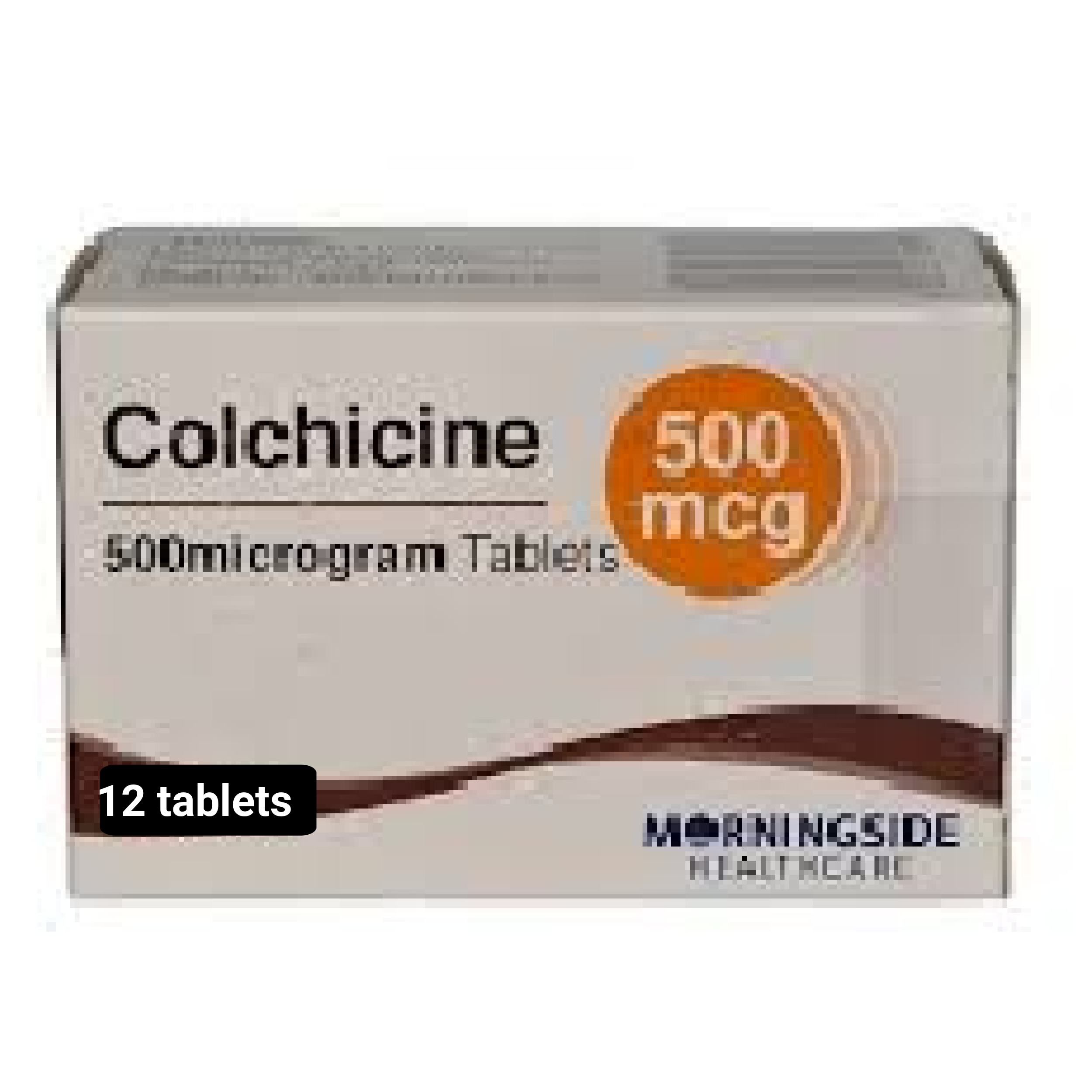Gout
Crushed by crystals? Smash gout pain before it strikes!
Fast, effective relief from gout pain with prescription colchicine tablets
Order online for quick, discreet delivery straight to your door
Find the right gout treatment for you
View All ProductsFrequently asked questions about genetic testing
Gout happens when there’s too much uric acid in your body. Uric acid is a natural waste product that forms when your body breaks down substances called purines. You get purines from certain foods—like red meat, seafood, and some drinks—as well as from your own cells. Usually, your kidneys filter out uric acid, which is then excreted in your urine. However, if your kidneys can’t keep up, or if your body produces too much uric acid, it begins to accumulate. When uric acid levels get too high, sharp crystals can form in your joints. These crystals cause the pain, swelling, and redness that are classic signs of a gout attack.
Certain factors can increase your risk of gout, including other health conditions (such as diabetes, kidney disease, high blood pressure, obesity, and psoriasis), specific medications (like diuretics and low-dose aspirin), your diet, and the amount of alcohol you consume. Family history can also play a part.
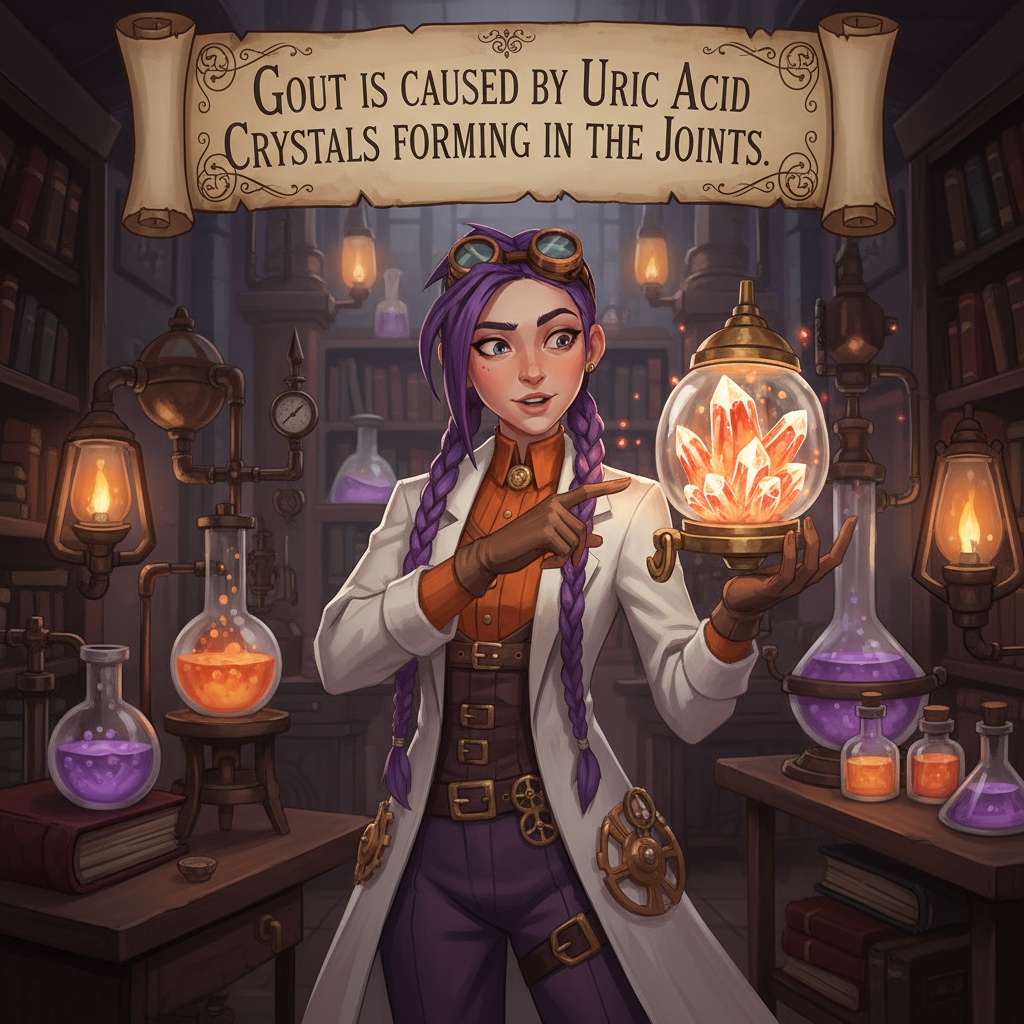
Yes, diet can make a real difference when it comes to gout. Foods high in purines—like red meat, offal (such as liver and kidneys), seafood, yeast extracts (like Marmite), and sugary drinks—can raise your uric acid levels and increase your risk of gout attacks. Even some vegetables, such as mushrooms and asparagus, contain purines, but they’re less likely to trigger gout than animal-based foods.
On the positive side, certain foods may help lower uric acid levels. For example, vitamin C and cherry juice may have a small effect; however, it is always recommended to consult your doctor before starting any new supplements. The best approach is to eat a healthy, balanced diet, drink plenty of water, and try to limit alcohol—especially beer and spirits—as these can also increase your risk.
There are two main types of medicine used to manage gout:
Medicines to lower uric acid and prevent future attacks:
These include allopurinol and febuxostat. These medicines help keep your uric acid levels low, making it less likely for crystals to form. If you have frequent gout attacks, your doctor may recommend starting one of these medicines even when you’re not having symptoms.We offer a variety of specialised genetic tests tailored to different health needs:
Medicines to relieve pain and swelling during a gout attack:
These include colchicine, corticosteroids, and nonsteroidal anti-inflammatory drugs (NSAIDs) like ibuprofen. Colchicine is often used if you can’t take NSAIDs. It works best if you take it as soon as a gout attack starts. The usual dose is one tablet, two to four times a day, but you should never take more than 12 tablets during a single attack. It’s important to avoid grapefruit juice while using colchicine, as it can increase the drug’s level in your blood. Always follow your doctor’s advice.
There’s currently no cure for gout, but it can be managed effectively with the proper treatment and lifestyle changes. Medicines like allopurinol and febuxostat help keep your uric acid levels low, which reduces the risk of future attacks and long-term joint damage.
Alongside medication, making healthy lifestyle choices—such as maintaining a healthy weight, staying active, drinking plenty of water, and reducing alcohol consumption—can make a significant difference. With good management, many people with gout go for long periods without any symptoms.
Like all medicines, gout treatments can have side effects. Colchicine, for example, can cause nausea, vomiting, tummy pain, and diarrhoea. If you experience any of these, speak to your doctor—they may need to change your dose or switch you to a different medicine.
In rare cases, colchicine can cause more serious problems such as fever, mouth inflammation, unexplained bruising or bleeding, or skin rashes. If you notice any of these, seek medical help immediately. Other gout medications, such as allopurinol and febuxostat, can sometimes cause rashes or stomach upset; however, most people tolerate them well with proper monitoring.
The primary cause of gout is the accumulation of uric acid in the body. When uric acid levels become too high, it can form sharp crystals in the joints, leading to the pain and swelling typical of a gout attack. This buildup can occur if your body produces too much uric acid or if your kidneys can’t remove it quickly enough.
Yes, absolutely. Gout often starts in one joint—most commonly the big toe—but over time, it can affect other joints such as the ankles, knees, elbows, wrists, and fingers. If gout isn’t managed well, it can become more widespread and even affect several joints at once.
Most gout attacks last between 3 and 10 days. The pain is usually worst in the first 24 hours, then gradually gets better over the next few days. Some people have milder attacks that go away quickly, while others might have more severe or longer-lasting pain and swelling. With proper treatment, the symptoms often improve more quickly.
Yes, you can lower your risk of gout with a few healthy habits. Maintaining a healthy weight, eating a balanced diet, drinking plenty of water, and limiting alcohol—especially beer and spirits—can all contribute to a healthier lifestyle. Avoiding foods high in purines, such as red meat and seafood, and staying active are also beneficial. If you have frequent attacks, your doctor may recommend medication to keep your uric acid levels low and help prevent future flares.
Yes, there are some foods you should try to limit if you’re prone to gout. These include red meat, offal (such as liver and kidneys), seafood, yeast extracts (like Marmite), and sugary beverages. These foods are high in purines, which can raise uric acid levels in the body. While some vegetables contain purines, they’re less likely to trigger gout attacks. It’s also a good idea to limit alcohol, particularly beer and spirits, as these can increase your risk too.
Additional information
Gout
Gout is a type of arthritis that causes painful swelling in the joints, resulting from the formation of crystals. It’s actually the most common kind of inflammatory arthritis. More people are developing gout these days, primarily due to changes in our diet, lifestyle, and environmental factors [1], [2].
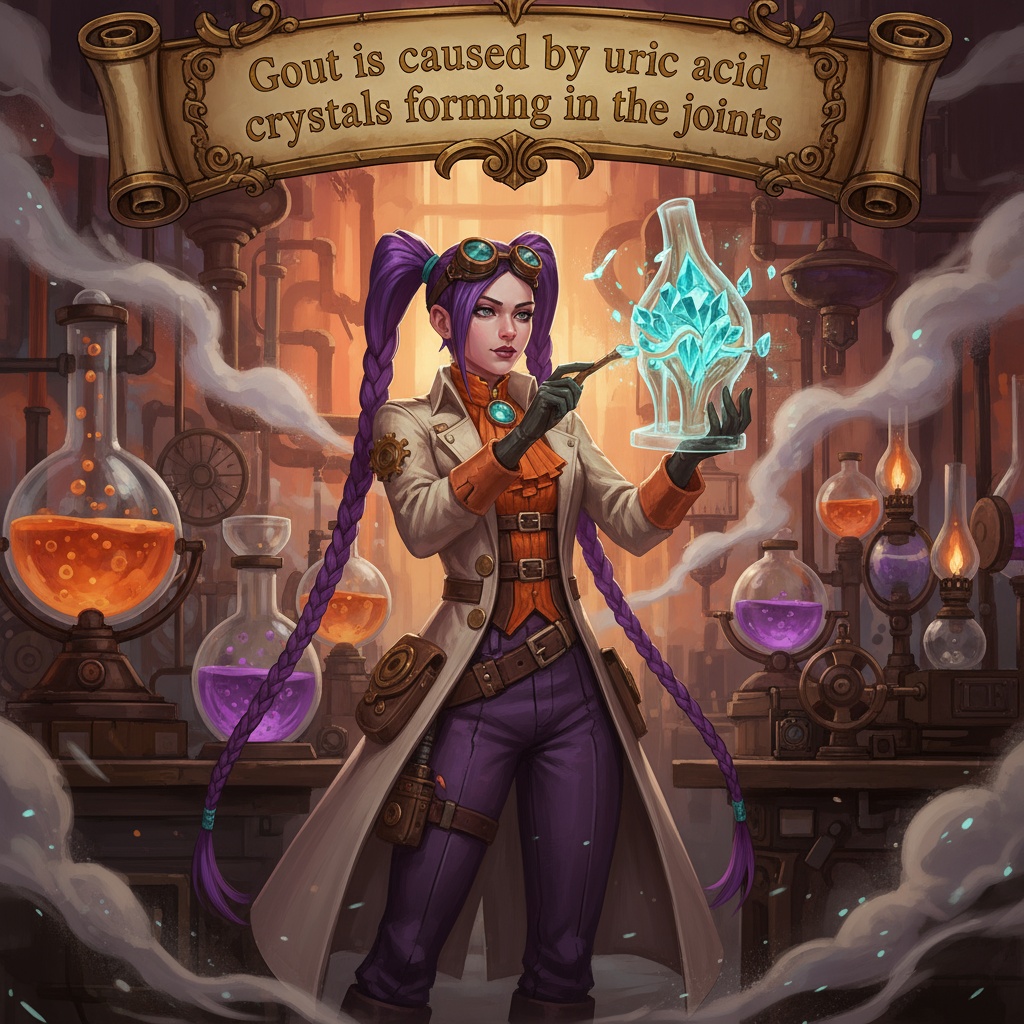
What is gout
Gout is the most common type of arthritis that causes inflammation in adults. It occurs when there is an excessive amount of uric acid in the blood, resulting in the formation of monosodium urate (MSU) crystals in the joints [3].
The prevalence of gout and its incidence are increasing worldwide [4].

What happens in an acute attack of gout?
A typical gout attack comes on suddenly, with severe pain and swelling—usually in a joint in the lower part of the body, like the big toe. Sometimes, the swelling can also affect nearby tissues, such as tendons. These attacks typically improve on their own within one to two weeks. After an attack, there’s often a period with no pain until the next flare happens [5].
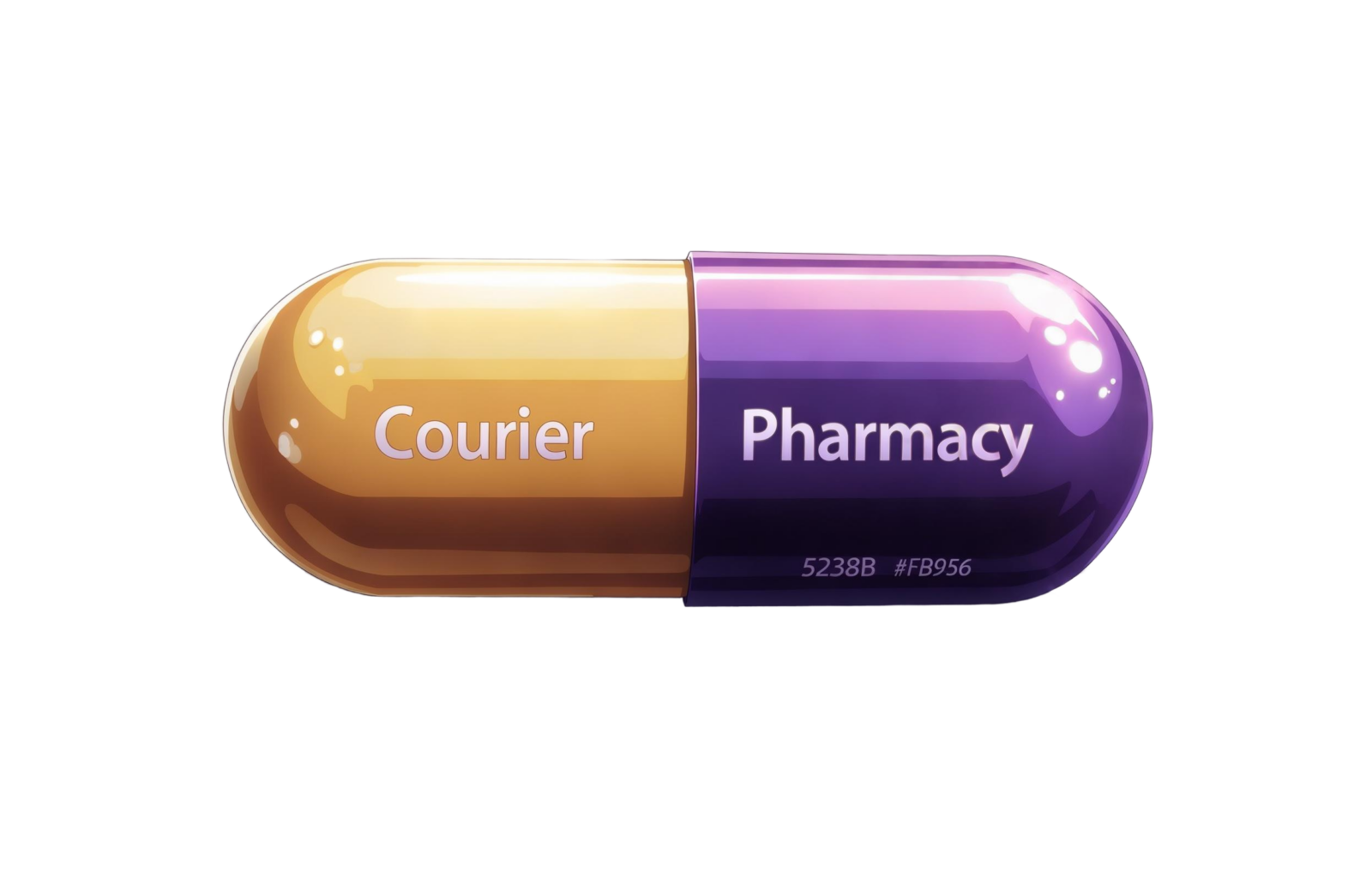
The stages of gout
Gout develops in stages. First, there’s a high level of uric acid in the blood (called hyperuricemia). Not everyone with high uric acid gets gout, but some people start to form crystals in their joints. When the body reacts to these crystals, it causes a painful gout flare. Over time, repeated attacks can lead to the formation of lumps called tophi, which may damage the joints [3].
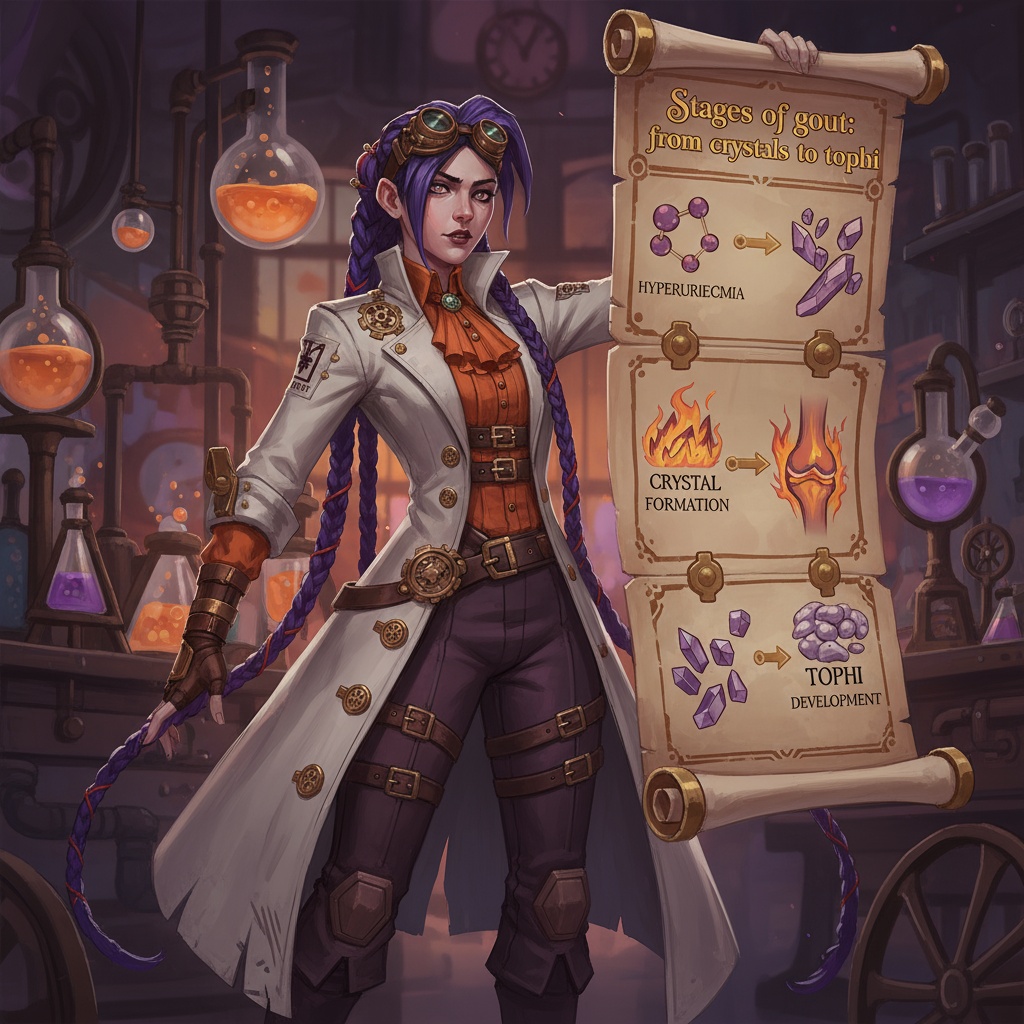
What causes high uric acid?
You need high uric acid to develop gout, but not everyone with high levels will get it. About 1 in 5 men with a uric acid level higher than 9.0 mg/dL will develop gout within five years [6].
Uric acid comes from breaking down purines, which are natural substances found in many foods and in our body’s cells. When purines break down, they produce uric acid as a waste product. Eating foods high in purines—such as red meat, seafood, and certain vegetables—can increase uric acid levels in the blood, which may increase the risk of gout.
Usually, uric acid is dissolved in the blood and removed by the kidneys and intestines.
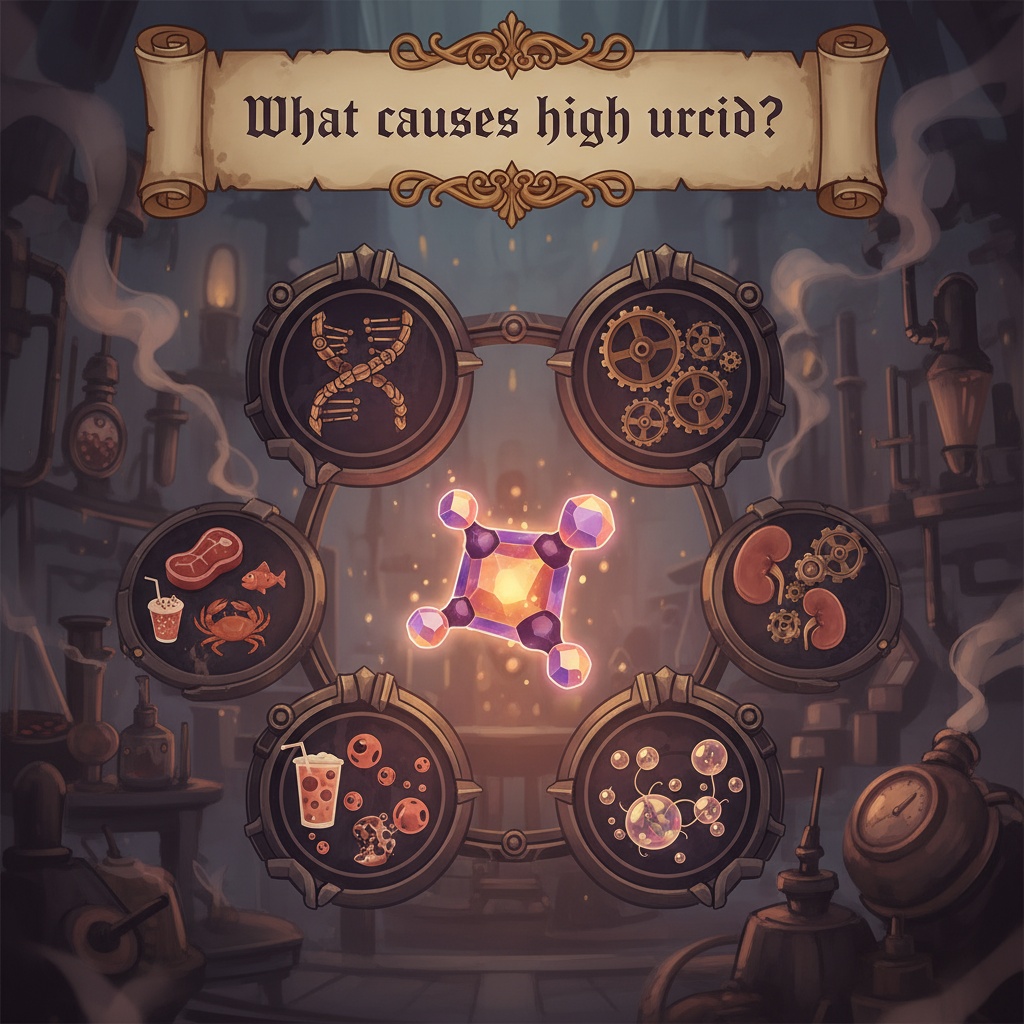
Can a tiger get gout?
OK, so if gout is caused by eating too much red meat, it begs the question, can meat eaters, like a tiger, get gout? The answer is no, thankfully for the tiger, since they are carnivores. So, why don’t tigers get gout?
The answer is that most mammals have an enzyme called uricase that turns uric acid into a form that’s easy to get rid of. Humans and some other primates don’t have the enzyme uricase.
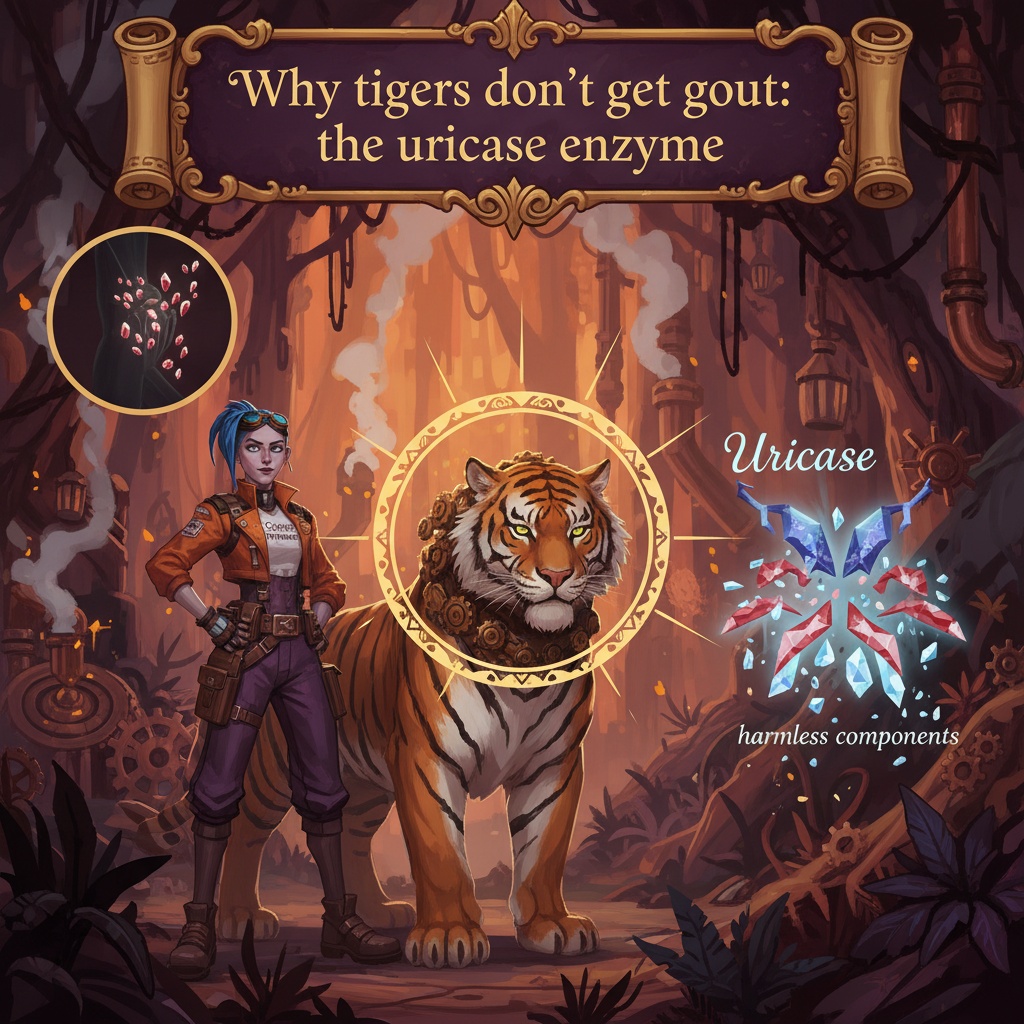
The uricase enzyme
Uricase is an enzyme made in the liver. It helps break down uric acid, converting it into a form that dissolves in water, allowing your kidneys to eliminate it easily [7].
The interesting thing is that humans and primates had this enzyme long ago, but due to genetic mutations, they lost the ability to produce it [8]. Why this happened has led to several interesting theories, which we will not explore now, but save for a blog post for another time.

Do high uric acid levels depend on genes or diet?
High uric acid levels occur when the body produces too much or the kidneys and intestines cannot eliminate it quickly enough. Eating lots of meat, seafood, drinking alcohol, and sugary drinks can raise uric acid levels [9], [10], [11]. However, genes have a greater impact on your risk of gout than diet alone [12].
The kidneys play a significant role in regulating uric acid levels. Special transporters in the kidneys and intestines facilitate the movement of uric acid in and out of the blood. Some people have genetic differences in these transporters, which can increase their likelihood of having high uric acid levels [13].
Other factors that can increase uric acid levels include being overweight, certain medications (such as diuretics, cyclosporine, or low-dose aspirin), and even changes in gut bacteria [14], [15].
What happens during a gout attack?
A gout attack happens when the body’s immune system reacts to tiny uric acid crystals that build up in a joint [16]. This reaction causes the joint to become very painful, swollen, red, and hot—often all of a sudden.
The body’s alarm system: how inflammation starts
When uric acid crystals settle in a joint, special immune cells (called macrophages) spot them and sound the alarm. They use a kind of “sensor” called the NLRP3 inflammasome, which acts like a fire alarm for the body. Once this alarm goes off, it sets off a chain reaction, leading to the release of powerful substances called cytokines (especially one called IL-1B). These cytokines cause the joint to become inflamed and attract additional immune cells to the area, resulting in further swelling and pain [16].
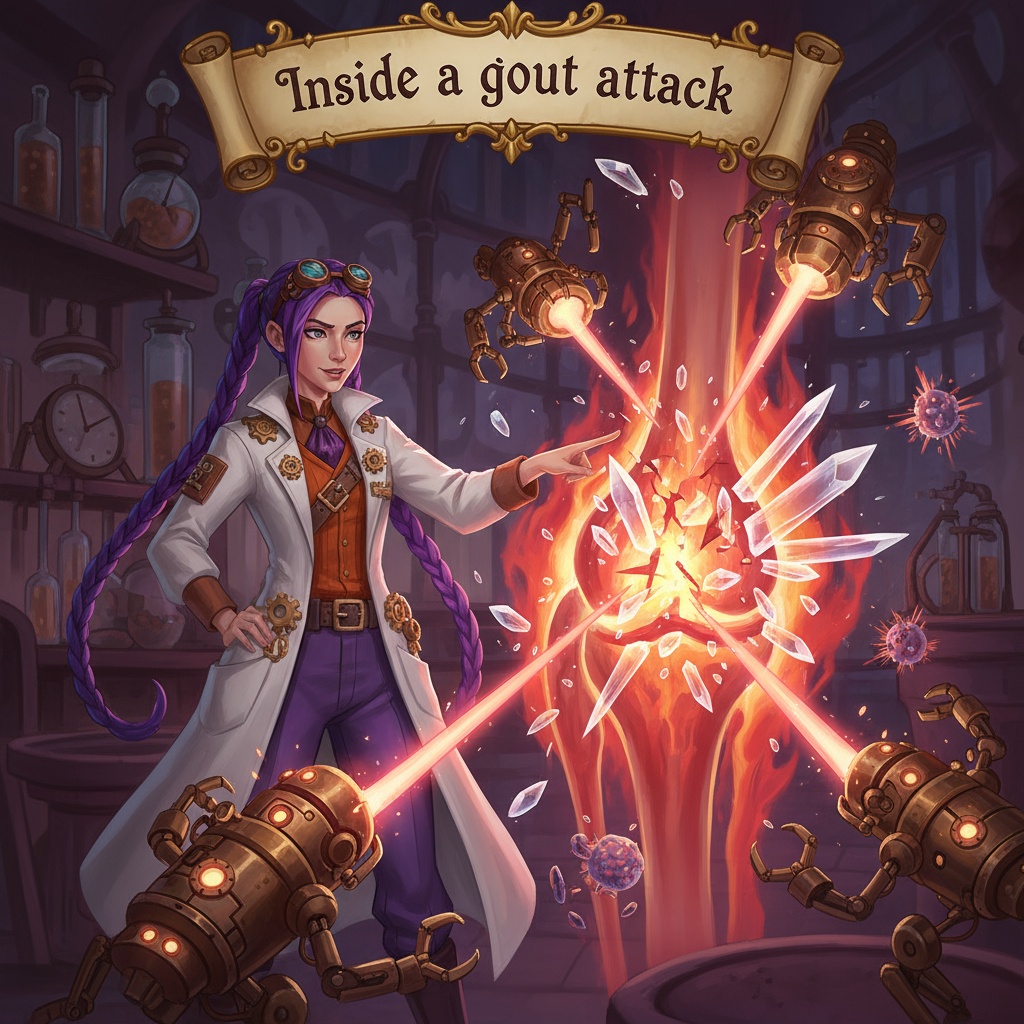
Two steps to a gout flare
For this process to start, two things need to happen:
- Priming: The immune cells get ready to respond. This can be triggered by things like infections, stress, or other signals in the body [17].
- Activation: The immune cells swallow up uric acid crystals in a joint, which sets off a chain reaction inside the cell that triggers strong inflammation and pain, which is a big part of what causes a gout attack [18].

Why does the pain go away on its own?
Interestingly, gout flares usually settle down without treatment after a week or two. This is because, after a while, the immune system calms itself down. Special cells (neutrophils) and proteins help clear away the inflammation and repair the joint, so the pain and swelling fade [19].
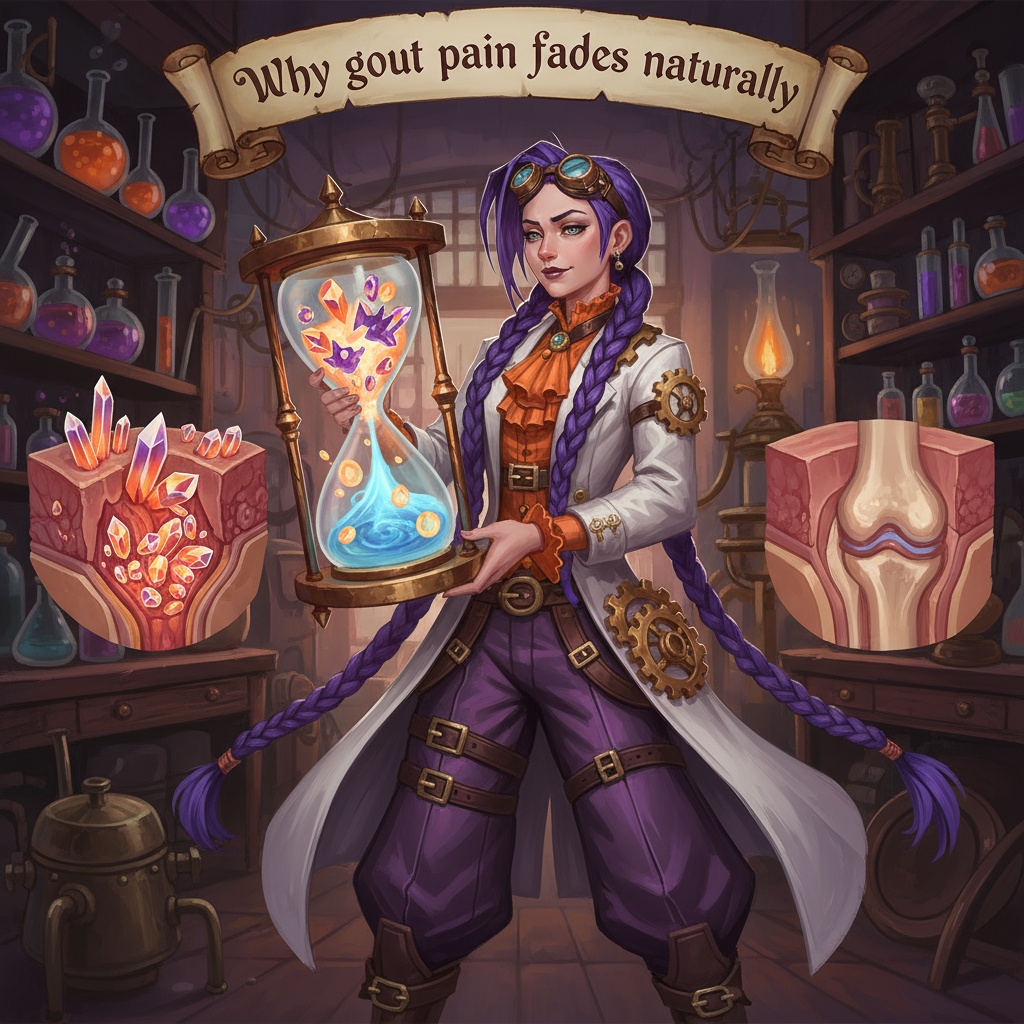
Why do some people experience more severe attacks?
Some people’s bodies are more sensitive to uric acid crystals, or they have other factors (like damaged joints or specific genes) that make flares more likely or more severe. Other immune cells called neutrophils can also get involved, making the inflammation worse at first, but then helping to clean up and quiet things down later [19].
What are tophi?
Advanced gout happens when uric acid crystals build up over many years, forming hard lumps called tophi in and around the joints, bones, tendons, and sometimes even under the skin. These tophi can cause long-lasting swelling, pain, and damage to the joints.
Tophi usually show up after having gout for a long time—often 10 years or more—especially if your uric acid levels have stayed high, but they can appear sooner in some people, especially if the kidneys aren’t working well.
Inside a tophus, there’s a mix of crystals, immune cells, and scar-like tissue, leading to ongoing inflammation. These lumps can eat away at bone and cartilage, making joints weaker and more susceptible to damage. Over time, this can lead to joint deformity and make it harder to move the affected area [20].

Treating gout flare-ups
When you experience a gout attack, the goal is to reduce pain and swelling as quickly as possible. Doctors usually prescribe anti-inflammatory medications, such as NSAIDs (e.g., ibuprofen) or corticosteroids.
Another medicine, colchicine, can also help calm the inflammation. It’s often used when starting long-term uric acid-lowering treatment or during acute attacks.
Newer drugs that target the inflammation-causing chemicals (like IL-1?) are available for severe cases [21].

Lowering uric acid long-term
Doctors recommend keeping uric acid levels below 6 mg/dL for most people with gout, and below 5 mg/dL if you have tophi [22]. Some guidelines even suggest lowering uric acid in people without gout if levels are very high [23].
To prevent future attacks, doctors prescribe medicines that lower uric acid levels. The most common are xanthine oxidase inhibitors, such as allopurinol and febuxostat. These drugs work by blocking the enzyme your body uses to make uric acid, so less is produced [24].
Allopurinol has been used for many years and has helped many people; however, not everyone reaches the target uric acid level with it. Febuxostat is a newer option and may work better for some people [24].
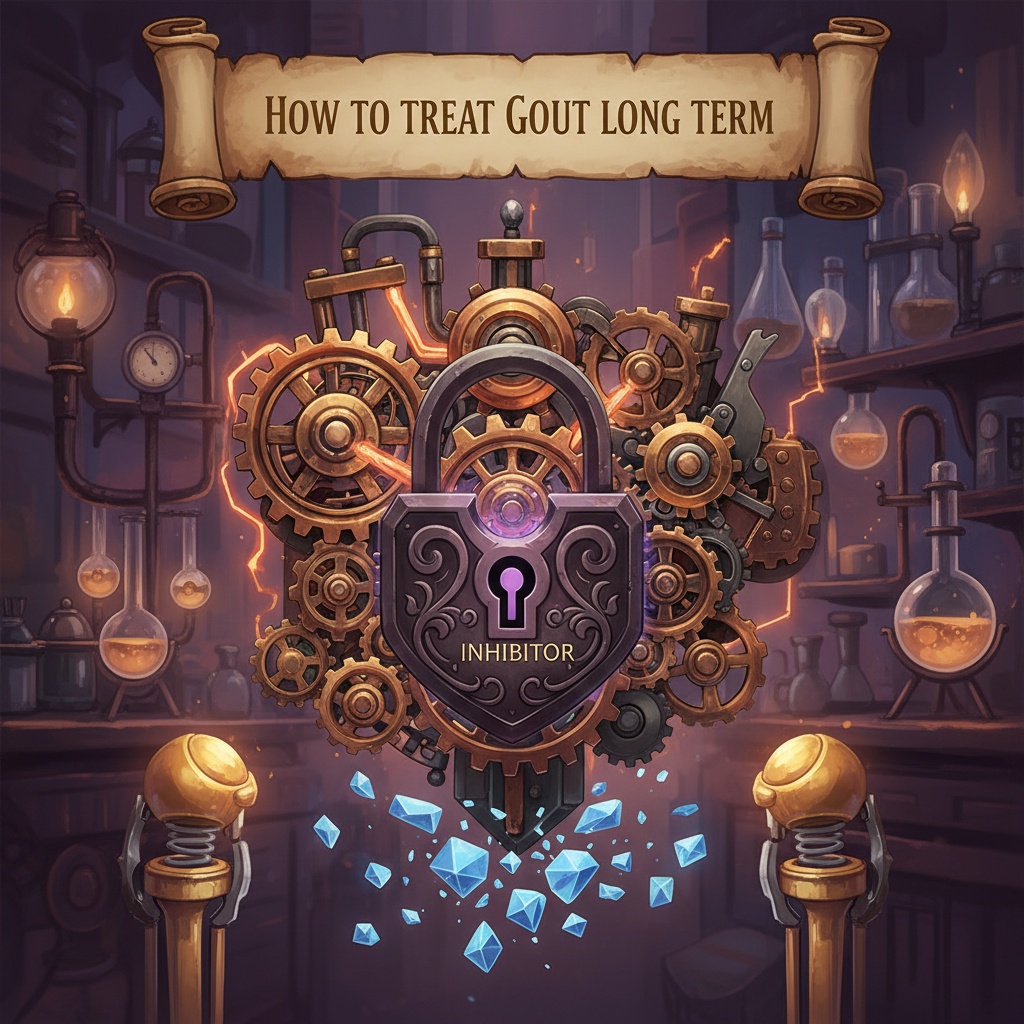
Other treatments and new developments
Some older drugs help the body get rid of uric acid through the kidneys, but they’re used less now because of side effects. New acid-lowering uric acid medicines are being developed to work more effectively and cause fewer side effects [21], [24].
For severe gout that doesn’t respond to other treatments, there are special medicines made from uricase enzymes (which humans lack naturally) that break down uric acid. One, called pegloticase, is approved for these cases [21].

Does gout only affect feet and toes?
Gout can affect any joint in the body, but it’s most commonly associated with causing pain in the big toe. Other joints that can be affected include the knee, elbow, wrist, fingers, and ankle [1][2].

What are the symptoms of gout?
The main symptoms of gout are:
- Intense pain in one or more joints (usually just one at a time)
- Hot, tender joints that are sensitive even to light touch (even a bed sheet can feel unbearable!)
- Swelling in and around the joint
- Red, shiny skin over the joint
- As the pain eases, you might notice the skin becoming itchy or flaky
A gout attack can last from 3 to 10 days, and the pain usually goes away on its own. If you experience these symptoms for the first time, it’s essential to see a doctor right away [1][2].
Get medical help straight away if you have severe pain that gets worse, swelling, and a high temperature (38 °C or more).

How do you test for gout?
If you’re experiencing symptoms that may be indicative of gout, getting tested is the best way to confirm the diagnosis. Testing helps rule out other causes of joint pain. Usually, this involves a blood test to check your uric acid levels. It’s best to wait about four weeks after a gout attack before testing, as uric acid levels can drop during an attack [1].
Your GP can arrange a blood test, or you can use a home test kit available from some pharmacies, including Courier Pharmacy. The test involves pricking your finger to get a drop of blood, which is then analysed for uric acid. Your results will help your doctor decide the best next steps [1].
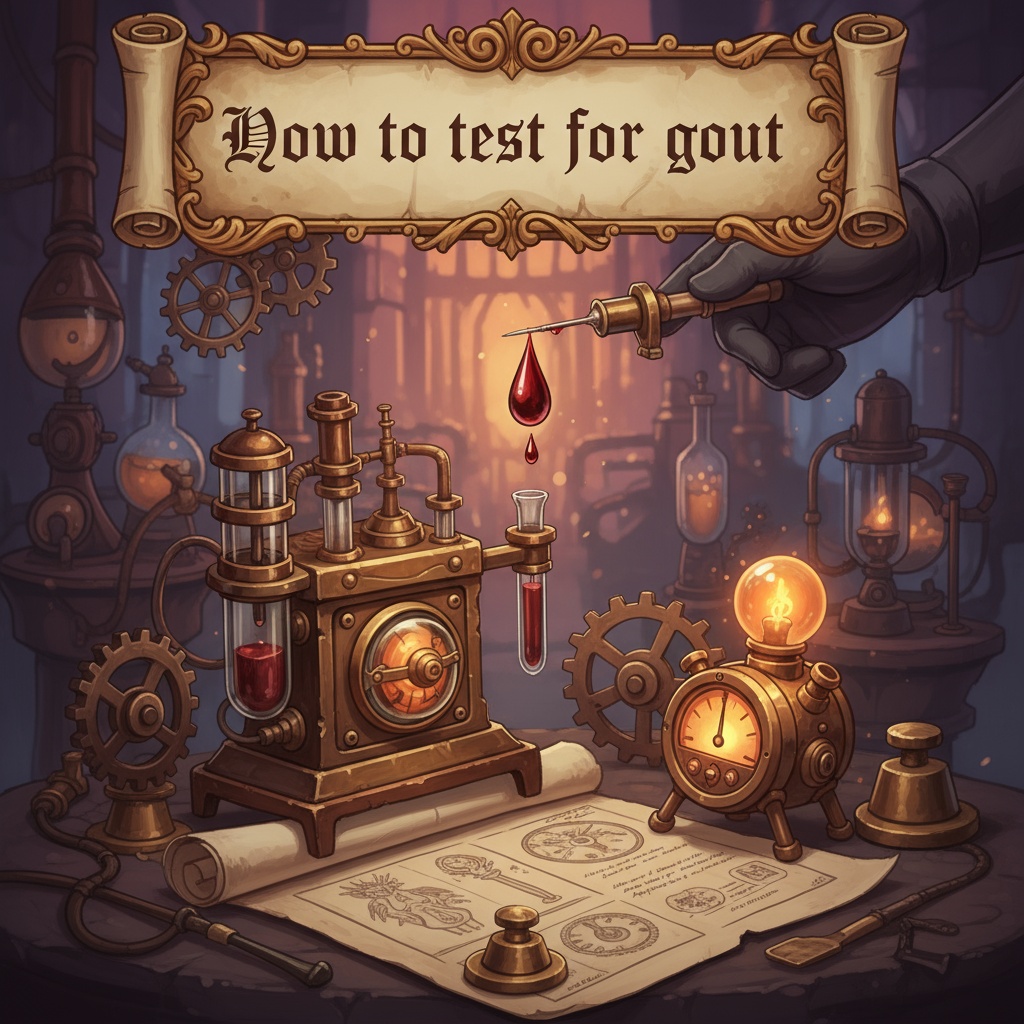
How does colchicine work?
When a gout attack happens, it can be extremely painful and uncomfortable. To manage this, doctors often prescribe colchicine, a medicine that helps reduce inflammation and ease the pain.
Colchicine is a medication derived from the autumn crocus plant, and it works by calming the immune system’s response to uric acid crystals. When these crystals accumulate in a joint, the immune system sends white blood cells to attack them, resulting in inflammation, redness, and pain.
Colchicine stops the white blood cells from gathering around the crystals and releasing substances that cause swelling and discomfort. This reduces the severity of the attack and helps you feel better faster [25].
It’s most effective when taken as soon as symptoms start. Typically, colchicine is administered in small doses over several days to alleviate the flare-up. A typical dose for adults is:
500 micrograms 2–4 times a day until symptoms are relieved, total dose per course should not exceed 6 mg, do not repeat course within 3 days. [26].
However, it can cause side effects such as stomach upset, nausea, or diarrhoea, especially when taken in higher doses, so it’s essential to follow your doctor’s instructions carefully [27].
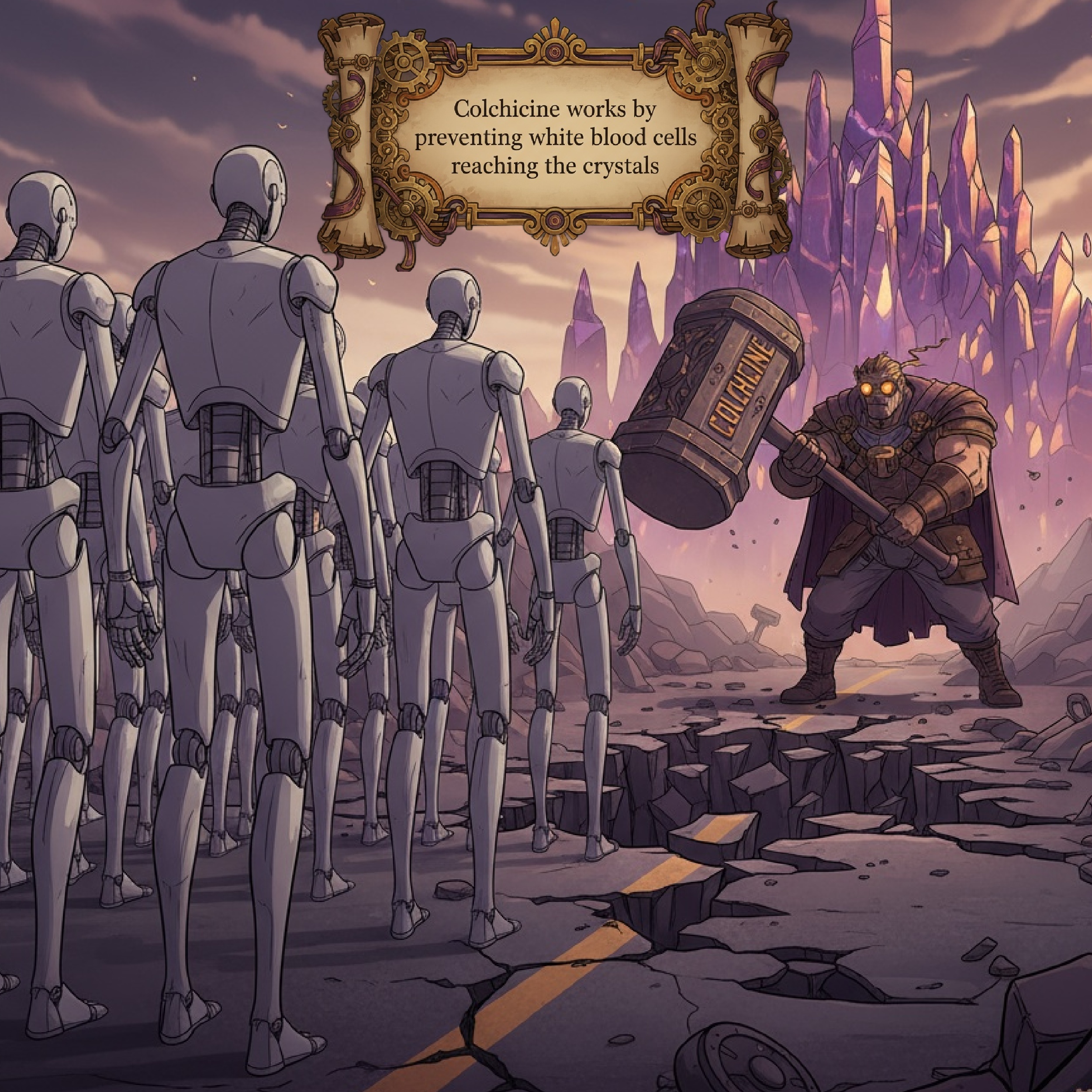
Can I buy colchicine online in the UK?
Yes, you can. Complete the online consultation form at Couier Pharmacy, and our team of prescribers will assess whether colchicine is suitable for you

Disclaimer: This article is for informational purposes only and does not replace professional medical advice.
References
- NHS (2023) Gout. Available at: https://www.nhs.uk/conditions/gout/ (Accessed: 7 October 2025).
- Doherty M. New insights into the epidemiology of gout. Rheumatology. 2009;48(suppl_2):ii2-ii8.
- Ahn, E.Y. and So, M.W., 2025. The pathogenesis of gout. Journal of rheumatic diseases, 32(1), pp.8-16.
- Dehlin M, Jacobsson L, Roddy E. 2020; Global epidemiology of gout: prevalence, incidence, treatment patterns and risk factors. Nat Rev Rheumatol. 16:380–90.
- Neogi T, Jansen TL, Dalbeth N, Fransen J, Schumacher HR, Berendsen D, et al. 2015; 2015 Gout classification criteria: an American College of Rheumatology/European League Against Rheumatism collaborative initiative. Ann Rheum Dis. 74:1789–98.
- Campion EW, Glynn RJ, DeLabry LO. 1987; Asymptomatic hyperuricemia. Risks and consequences in the Normative Ageing Study. Am J Med. 82:421–6.
- Gustafsson D, Unwin R (2013) The pathophysiology of hyperuricaemia and its possible relationship to cardiovascular disease, morbidity and mortality. BMC Nephrol 14:164
- Chang, B.S., 2014. Ancient Insights into Uric Acid Metabolism in Primates. Proceedings of the National Academy of Sciences, 111(10), pp.3657-3658.
- Zhang Y, Chen C, Choi H, Chaisson C, Hunter D, Niu J, et al. 2012; Purine-rich foods intake and recurrent gout attacks. Ann Rheum Dis. 71:1448–53.
- Choi HK, Atkinson K, Karlson EW, Willett W, Curhan G. 2004; Alcohol intake and risk of incident gout in men: a prospective study. Lancet. 363:1277–81.
- Choi HK, Curhan G. 2008; Soft drinks, fructose consumption, and the risk of gout in men: prospective cohort study. BMJ. 336:309–12.
- Topless, R.K., Major, T.J., Florez, J.C., Hirschhorn, J.N., Cadzow, M., Dalbeth, N., Stamp, L.K., Wilcox, P.L., Reynolds, R.J., Cole, J.B. and Merriman, T.R., 2021. The comparative effect of exposure to various risk factors on the risk of hyperuricaemia: diet has a weak causal effect. Arthritis research & therapy, 23(1), p.75.
- Tin A, Marten J, Halperin Kuhns VL, Li Y, Wuttke M, Kirsten H, et al. 2019; Target genes, variants, tissues and transcriptional pathways influencing human serum urate levels. Nat Genet. 51:1459–74.
- Lyngdoh T, Vuistiner P, Marques-Vidal P, Rousson V, Waeber G, Vollenweider P, et al. 2012; Serum uric acid and adiposity: deciphering causality using a bidirectional Mendelian randomization approach. PLoS One. 7:e39321.
- Bruderer, S., Bodmer, M., Jick, S.S. and Meier, C.R., 2014. Use of diuretics and risk of incident gout: a population?based case–control study. Arthritis & rheumatology, 66(1), pp.185-196.
- Martinon, F., Pétrilli, V., Mayor, A., Tardivel, A. and Tschopp, J., 2006. Gout-associated uric acid crystals activate the NALP3 inflammasome. Nature, 440(7081), pp.237-241.
- Netea, M.G., Nold-Petry, C.A., Nold, M.F., Joosten, L.A., Opitz, B., van der Meer, J.H., van de Veerdonk, F.L., Ferwerda, G., Heinhuis, B., Devesa, I. and Funk, C.J., 2009. Differential requirement for the activation of the inflammasome for processing and release of IL-1? in monocytes and macrophages. Blood, The Journal of the American Society of Hematology, 113(10), pp.2324-2335.
- Hornung V, Bauernfeind F, Halle A, Samstad EO, Kono H, Rock KL, et al. 2008; Silica crystals and aluminum salts activate the NALP3 inflammasome through phagosomal destabilization. Nat Immunol. 9:847–56.
- Schauer C, Janko C, Munoz LE, Zhao Y, Kienhöfer D, Frey B, et al. 2014; Aggregated neutrophil extracellular traps limit inflammation by degrading cytokines and chemokines. Nat Med. 20:511–7.
- Chhana A, Pool B, Callon KE, Tay ML, Musson D, Naot D, et al. 2018; Monosodium urate crystals reduce osteocyte viability and indirectly promote a shift in osteocyte function towards a proinflammatory and proresorptive state. Arthritis Res Ther. 20:208.
- Crittenden, D.B. and Pillinger, M.H., 2013. New therapies for gout. Annual review of medicine, 64(1), pp.325-337.
- Khanna, D., Fitzgerald, J.D., Khanna, P.P., Bae, S., Singh, M.K., Neogi, T., Pillinger, M.H., Merill, J., Lee, S., Prakash, S. and Kaldas, M., 2012. 2012 American College of Rheumatology guidelines for management of gout. Part 1: systematic nonpharmacologic and pharmacologic therapeutic approaches to hyperuricemia. Arthritis care & research, 64(10), pp.1431-1446.
- Yamanaka, H., 2011. Japanese guideline for the management of hyperuricemia and gout. Nucleosides, Nucleotides and Nucleic Acids, 30(12), pp.1018-1029.
- Gustafsson, D. and Unwin, R., 2013. The pathophysiology of hyperuricaemia and its possible relationship to cardiovascular disease, morbidity and mortality. BMC nephrology, 14(1), p.164.
- Leung, Y.Y., Hui, L.L.Y. and Kraus, V.B., 2015, December. Colchicine—update on mechanisms of action and therapeutic uses. In Seminars in arthritis and rheumatism (Vol. 45, No. 3, pp. 341-350). WB Saunders.
- BNF (2025) Colchicine: indications and dose. Available at: https://bnf.nice.org.uk/drugs/colchicine/#indications-and-dose (Accessed: 7 October 2025).
- https://www.medicines.org.uk/emc/product/6415/smpc

BSc Pharmacy, Independent Prescriber, PgDip Endocrinology, MSc Endocrinology, PgDip Infectious Diseases
Superintendant Pharmacist, Independent Prescriber
BSc Pharmacy
Compounding Pharmacist
